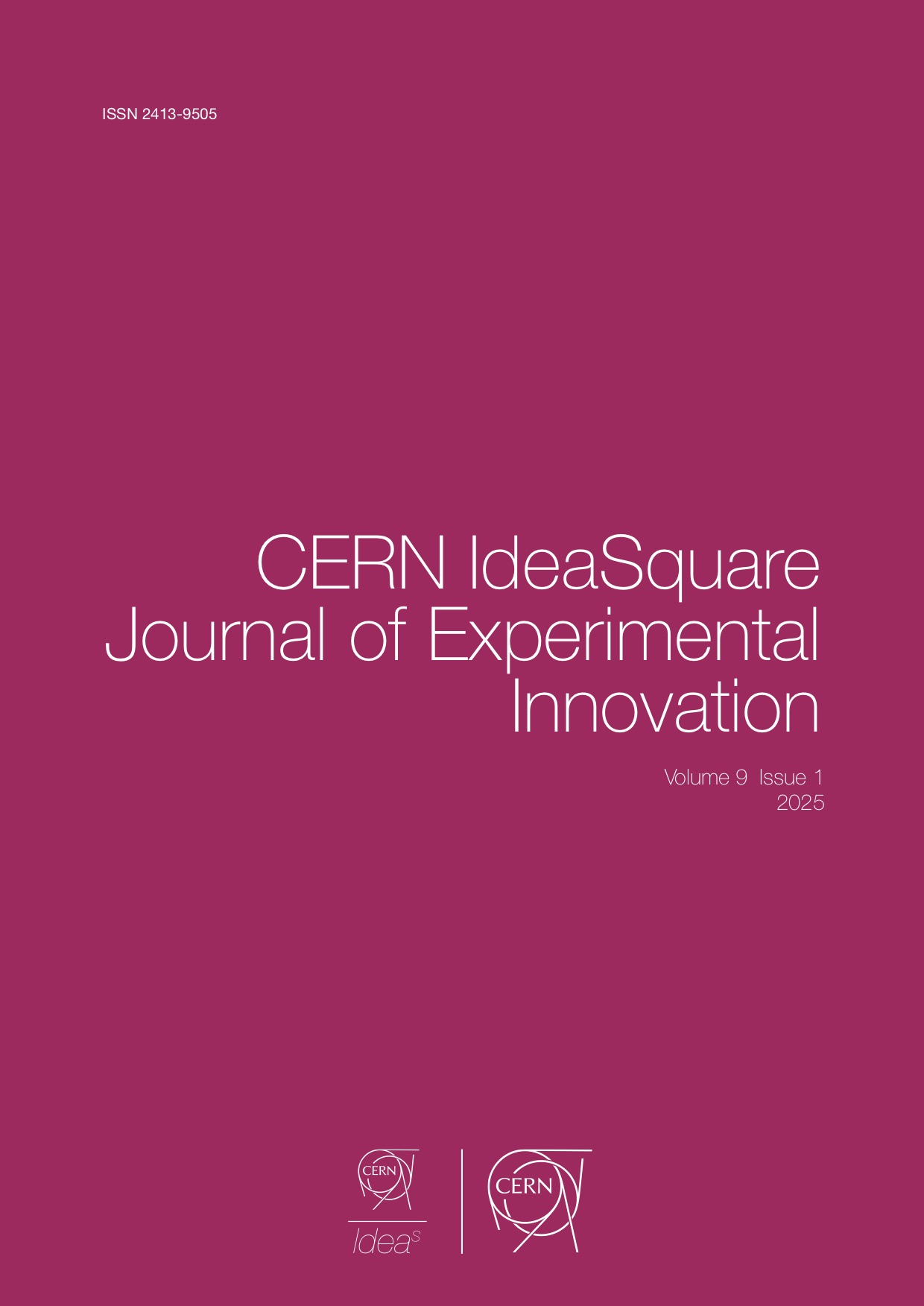Shaping Creativity: What Participants Say Works (and Doesn’t) in Short-Term Educational Teams
DOI:
https://doi.org/10.23726/cij.2025.1485Keywords:
Creativity, Education, Design thinking, InnovationAbstract
Creativity is a critical 21st century skill that generates innovative solutions to complex problems. This study examines participant perceptions on creativity during a three-week summer school where multidisciplinary teams developed novel applications for innovative technologies. Participants were surveyed on the effectiveness of the tools and techniques used. Findings highlight prototyping and external team interactions as major creativity enhancers. Relational rewards, breaks, and icebreakers were also perceived positively. However, certain tools such as supervisor influence and formal presentations were considered detrimental or ineffective. These findings offer practical insights for designing educational programs that stimulate creativity.
References
Amabile, T. M. (2012). Componential Theory of Creativity. Harvard Business School Working Paper, No. 12-096.
Bensalah, H., & Mâță, L. (2022). Transition from Knowledge Acquisition to Competency Development: Creativity as 21st Century Skill within Educational Framework. Journal of Innovation in Psychology, Education and Didactics, 26(2), 241-250. https://doi:10.29081/JIPED.2022.26.2.09
Brenner, P. S., & DeLamater, J. (2016). Lies, Damned Lies, and Survey Self-Reports? Identity as a Cause of Measurement Bias. Social Psychology Quarterly, 79(4), 333–354. https://doi.org/10.1177/0190272516670735
Bushong, B., & Gagnon-Bartsch, T. (2023). Reference dependence and attribution bias: Evidence from real-effort experiments. American Economic Journal: Microeconomics, 15(2), 271–308. https://doi.org/10.1257/mic.20210207
Edmondson, A. C. (2018). The fearless organization: Creating psychological safety in the workplace for learning, innovation, and growth. John Wiley & Sons.
Fischer, C., Malycha, C. P., & Schafmann, E. (2019). The influence of intrinsic motivation and synergistic extrinsic motivators on creativity and innovation. Frontiers in Psychology, 10, 137. https://doi.org/10.3389/fpsyg.2019.00137
Griffiths, C., & Medlicott, C. (2024, October 14). Why your brainstorming sessions fail: How to unlock your team's true creative potential. Training Journal. Retrieved April 10, 2025, from https://www.trainingjournal.com/2024/content-type/features/why-your-brainstorming-sessions-fail-how-to-unlock-your-teams-true-creative-potential/
Hoseini Shavoun, A., Adeli, S. H., & Ahmari-Tehran, H. (2024). Fostering engagement: A review of icebreakers in academic environments. Medical Education Bulletin, 5(2), 949–959. https://doi.org/10.22034/MEB.2024.495642.1105
Jones, M.S., Cravens, A.E., Zarestky, J., Ngai, C., & Love, H. B. (2024). Facilitating psychological safety in science and research teams. Humanities and Social Science Communication, 11, 1632. https://doi.org/10.1057/s41599-024-04037-7
Kaplan, D. E. (2019). Creativity in education: Teaching for creativity development. Psychology, 10(2), 140-147. https://doi.org/10.4236/psych.2019.102012
Komarova, M., Ivanova, A., Petrova, N., & Sidorov, D. (2023). Group dynamics and creativity: a research with young adults in Reggio Emilia, Italy. Creativity Studies, 16(1), 297–314. https://doi.org/10.3846/cs.2023.17564
Lee, C. (2020). Qualitative Oral-Presentation Feedback: Comparisons from Business Professionals, Instructors, and Student Peers. SAGE Open, 10(1), 1–15. https://doi.org/10.1177/23294906221120015
Linhardt, R. M., & Salas, E. (2023). Examining the fluidity of innovation teams: a conceptual framework. Frontiers in Psychology, 14, 1296651. https://doi.org/10.3389/fpsyg.2023.1296651
Mahajan, S. (2024). Navigating the cohesion-diversity trade-off: Understanding the role of facilitators in co-creation using agent-based modelling. Philosophical Transactions of the Royal Society A: Mathematical, Physical and Engineering Sciences, 382(2262). https://doi.org/10.1098/rsta.2024.0093
Malmelin, N., & Virta, S. (2016). Organising creative interaction: Spontaneous and routinised spheres of team creativity. Communication research and practice, 3(4), 299-318. https://doi.org/10.1080/22041451.2016.1229296
National Research Council (2012). Education For Life And Work: Developing Transferable Knowledge And Skills In The 21st Century. The National Academies Press.
Paulus, P. (2023). The Role of Psychological Safety in Team Communication: Implications for Human Resource Practices. Golden Ratio of Mapping Idea and Literature Format, 3(2), 156–166.
https://doi.org/10.52970/grmilf.v3i2.399
Paulus, P. B., Nakui, T., Putman, V. L., & Brown, V. R. (2006). Effects of task instructions and brief breaks on brainstorming. Group Dynamics: Theory, Research, and Practice, 10(3), 206-219. https://doi.org/10.1037/1089-2699.10.3.206
Paulus, P. B., & Nijstad, B. A. (2019). Introduction. En P. B. Paulus & B. A. Nijstad (Eds.), The Oxford Handbook of Group Creativity and Innovation (pp. 2–8). Oxford UniversityPress. https://doi.org/10.1093/oxfordhb/9780190648077.013.1
Paulus, P. B., & Nijstad, B. A. (2003). Group creativity: Innovation through collaboration. Oxford University Press. https://doi.org/10.1093/acprof:oso/9780195147308.001.0001
Podsakoff, P. M., MacKenzie, S. B., Lee, J.-Y., & Podsakoff, N. P. (2003). Common method biases in behavioral research: A critical review of the literature and recommended remedies. Journal of Applied Psychology, 88(5), 879–903. https://doi.org/10.1037/0021-9010.88.5.879
Rodriguez-Calero, I., Daly, S. R., Burleson, W., & Sienko, K. H. (2023). Prototyping strategies to engage stakeholders during early stages of design: A study across three design domains. Journal of Mechanical Design, 145(1), 011401. https://doi.org/10.1115/1.4056815
Vikas, T. N., Sreejith, S., & Suresh, M. (2022). Design thinking: A review paper. International Journal of Advanced Research in Science, Communication and Technology (IJARSCT), 2(2), 405–407. https://doi.org/10.48175/IJARSCT-2893
Downloads
Published
How to Cite
License
Copyright (c) 2025 Javier Páez Franco

This work is licensed under a Creative Commons Attribution 4.0 International License.
Authors who publish with this journal agree to the following terms:
- Authors retain copyright and grant the journal right of first publication with the work simultaneously licensed under a Creative Commons Attribution License that allows others to share the work with an acknowledgement of the work's authorship and initial publication in this journal.
- Authors are able to enter into separate, additional contractual arrangements for the non-exclusive distribution of the journal's published version of the work (e.g., post it to an institutional repository or publish it in a book), with an acknowledgement of its initial publication in this journal.
- Authors are permitted and encouraged to post their work online (e.g., in institutional repositories or on their website) prior to and during the submission process, as it can lead to productive exchanges, as well as earlier and greater citation of published work (See The Effect of Open Access).


